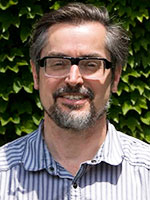Dr. Mario Ostrowski
Immune System Intricacies
Infectious disease clinician, University of Toronto and St. Michaels Hospital

As a medical student at the height of the epidemic in the late 1980s, it wasn’t hard for Mario Ostrowski to choose a research career in HIV. “I did my infectious disease training before we had a good combination of antivirals. I saw lot of HIV infection and a lot of people died,” he says. Today, he is an infectious disease clinician with the University of Toronto and St. Michaels Hospital and his research projects include several large CIHR team grants and the CANCURE Initiative.
The overall focus of his work is to understand the immune mechanisms that control HIV infection in order to develop HIV vaccines and therapeutics. Because of the complex relationship between the HIV virus and the human immune system, a vaccine has been difficult to develop. As Dr. Ostrowski explains, “just giving an antigen in a vaccine is not enough to control HIV. You may somehow have to regulate the immune system in such a way that when it sees the antigen the response is a lot more protective.” Ultimately he hopes his work can help to tackle to big task of developing treatments and a cure. “It’s a big challenge for me to see whether we can help to develop a cure or a vaccine for this infection. I want to try and figure out a way that we can make the immune system get rid of the virus.”
As part of a CIHR Team Grant, Dr. Ostrowski is investigating multiple aspects of the immunology of HIV infection in humans. His team is studying the CD40 ligand, 41BB ligand and the OX40 ligand within the TNF family of molecules. These ligands are important in coordinating both T cell and B cell responses to the HIV antigen. “We are trying to see which of these molecules either alone or in combo could be used in a vaccine to activate the immune system and optimise the immune response,” says Dr. Ostrowski. In collaboration with the University of Nairobi, the team grant also includes studies into the immune cells (B cells and iNOS-producing B cells) in the gut mucosa of HIV infected and uninfected people, an investigation of the effects of the varicella adjuvant on mucosal surfaces, and an assessment of the appropriateness of mucosal sampling (rather than blood) in vaccine clinical studies.
Recent work in cancer treatment is focussing on using the body’s own immune system to eradicate or control cancer and HIV research is heading in this direction too. With a Team Grant from CIHR, Dr. Ostrowski is trying to understand the mechanism of TIM3, a molecule associated with T cells that can’t seem to clear HIV. “If we can understand how this molecule prevents the T-cell from functioning properly, then maybe we can use a therapy to allow people to control the virus without the use of antiviral drugs.”
For up and coming young researchers, Dr. Ostrowski points out that studying new HIV infections might reveal important strategies for HIV treatment and a cure. “It’s an important group of people to study, because their immune system has only recently seen the virus. If we can understand how the immune system is responding to the virus in these very early stages of infection, maybe we can find the Achilles heel of the virus at that early stage.”
The Canadian Association for HIV Research (CAHR), the CIHR HIV/AIDS Research Initiative, the Canadian Foundation for AIDS Research (CANFAR), the CIHR Canadian HIV Trials Network (CTN) and the Canadian HIV Vaccine Initiative (CHVI) Research and Development Alliance Coordinating Office (ACO) would like to thank Dr. Ostrowski for his significant contributions to our understanding of HIV. His work is part of a larger Canadian research effort that is making a difference in the lives of those affected by HIV in Canada and around the world.
- Date modified: